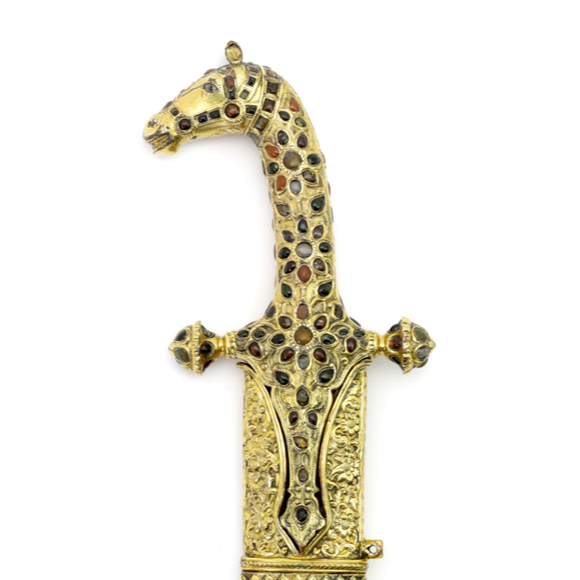With a fine wootz blade with a pronounced center ridge.

46 x 91.5 cm
Arrows; iron, steel, reed, bone, sinew, pigments, lacquer, silk
Board; chipboard, hardwood, brass and synthetic fabric
North India
18th-19th century
From a UK collection
Description
A group of 18 north Indian arrows mounted on a chipboard covered with fabric. The mounting is done by means of two cleverly shaped strips of dark hardwood, the upper one has slots to spread the arrows in a fan. The lower one holds them to the board. They are attached by means of screws so the arrows can come out easily.
The original backing fabric is green, I covered it with dark blue I had left over from my stand at PAN Amsterdam.
The arrows
Among the arrows are:
2 blunts, called tukkā (तुक्का).
3 variations to bodkin points.
1 very small sharp broadhead.
4 with katar-shaped heads.
1 heavy anti-siege head, called tarah-i-ḵẖāra (तरह इ खर), thorn-shaped.
7 crescent-shaped heads of several shapes and sizes called tarah-i-halāl (तरह इ हलाल) or bhalakā (भलका).
Arrows of these types were found in most north Indian armories. They were chiefly produced in Burhanpur, Jodhpur, and Bundi.2 Especially crescent arrowheads are very rare in today's antique market.
The nocks are a mix of wood and bone, some broken, see photos. I repaired a split shaft on one of the katar-headed arrows. Finish of the arrows varies from ordinary to very nicely painted shafts.
Notes
1. Saxena; The army of the Rajputs. Udaipur, Saroj Prakashan, 1989.
Comparable examples
Bundles of arrows containing those quite close to what we see here were published in Hendley, 1883:

Rajput Bows and Arrows
1. An unstrung bow of pieces of horn, united by gut, lacquered and painted. "Kamān."
2. Sheaf of Arrows, "tīr," cane with ivory rings, and perforated flat steel points.
3. Sheaf of Arrows with crescentic tops.
4. Sheaf of Arrows with flat tops.
5 and 6. Quiver, "tarkash," with small arrows, used for killing birds, or as toys.
From the Armoury of H.H. The Maharajah of Jeypore.
Hendley; Memorials of the Jeypore Exhibition 1883, vol II, plate XXXII.












The style typical of Kutch, the execution far above what is normally seen on work from that area.
Nice and complete with opaque green hilt and scabbard mounts.
With designs of animals, often attributed to Lucknow, north India.






